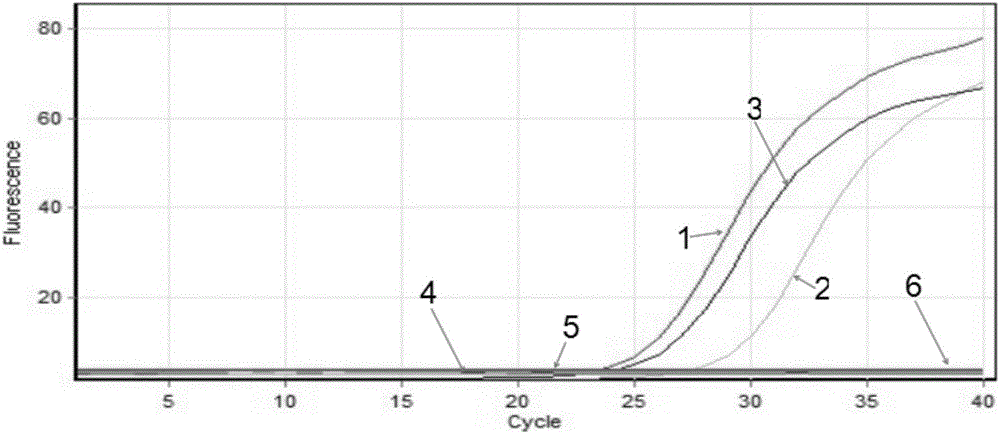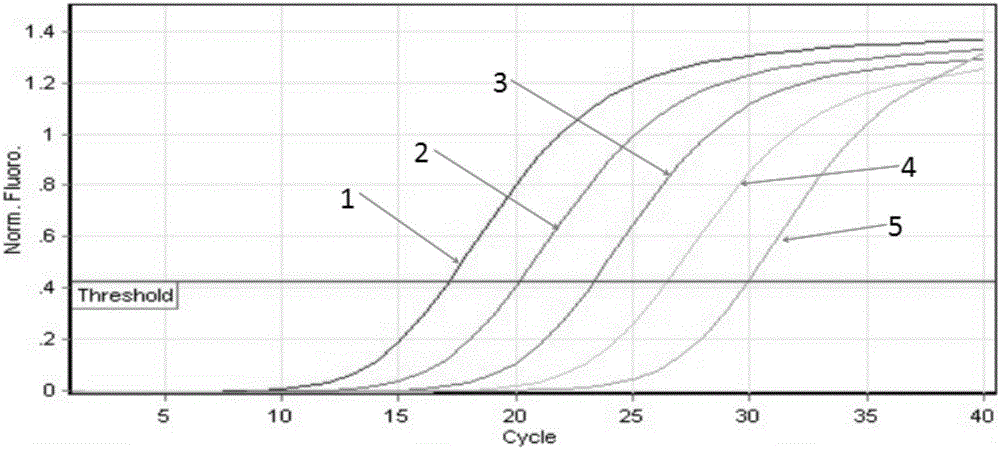Toxoplasma gondii fluorogenic quantitative PCR (polymerase chain reaction) specific primer, kit and detecting method of toxoplasma gondii fluorogenic quantitative PCR specific primer
A fluorescence quantitative and detection method technology, applied in biochemical equipment and methods, microbial determination/inspection, DNA/RNA fragments, etc., can solve the problems of low detection efficiency and insufficient detection sensitivity, and achieve high sensitivity and results. Judging the effect of objective and simple operation
- Summary
- Abstract
- Description
- Claims
- Application Information
AI Technical Summary
Problems solved by technology
Method used
Image
Examples
Embodiment 1
[0069] The composition of embodiment 1 kit
[0070] The kit contains:
[0071] 1) DNA extraction solution, which contains 50mL of Buffer GA, 50mL of Buffer GB, 52mL of Buffer GD, 50mL of Buffer PW, 60mL of Buffer TE, 4mL of Proteinase K, and 10mL of absolute ethanol that have been reacted 200 times;
[0072] 2) Fluorescent quantitative PCR reaction solution is SYBR Green I reagent reacted 200 times, Toxoplasma gondii-specific primer with a final concentration of 10 pmol / μL, sterilized double distilled water, MgCl2, dNTPs, Taq enzyme.
[0073] 3) The quality control reaction solution is a negative control reaction solution and a positive control reaction solution that have been reacted 200 times.
Embodiment 2
[0074] Embodiment 2 kit specificity test
[0075] Using DNA from RH strain, DNA from PRU strain, DNA from VEG strain, DNA from Isospora suis, DNA from Epierythropodium, and DNA from Neospora as templates, carry out specific fluorescent quantitative PCR amplification according to the reaction conditions of the kit, and set a blank at the same time control.
[0076] The reaction system was: SYBR Green I 10 μL, upstream and downstream primers 0.4 μL each, double distilled water 7.2 μL, template DNA 2 μL.
[0077] Fluorescent quantitative PCR amplification conditions are:
[0078]
[0079] The results showed that the DNA of different strains of Toxoplasma gondii had specific amplification, and the negative control and other DNAs had no amplification ( figure 1 ).
Embodiment 3
[0080] Standard curve and sensitivity analysis of embodiment 3 kit
[0081] respectively by 10 10 ~10 0 The plasmid standard product of copy / μL was used as a template for real-time fluorescent quantitative PCR amplification, and 5 consecutive points were selected to make a standard curve ( figure 2 ) and the standard equation (Table 1) and analyze its sensitivity, the results show that the fluorescent quantitative PCR has no amplification when the template concentration is below 10 copies / μL, and it can be concluded that the sensitivity of the fluorescent quantitative PCR is 10 copies of the target DNA .
[0082] Table 1 Toxoplasma gondii fluorescence quantitative PCR standard equation
[0083]
[0084] Note: x=lg (initial template concentration), CT value is the cycle number when the fluorescence signal reaches the set threshold.
[0085] In order to more truly reflect the gap between the theoretical lower limit of detection and the actual lower limit of detection, th...
PUM
 Login to View More
Login to View More Abstract
Description
Claims
Application Information
 Login to View More
Login to View More - R&D
- Intellectual Property
- Life Sciences
- Materials
- Tech Scout
- Unparalleled Data Quality
- Higher Quality Content
- 60% Fewer Hallucinations
Browse by: Latest US Patents, China's latest patents, Technical Efficacy Thesaurus, Application Domain, Technology Topic, Popular Technical Reports.
© 2025 PatSnap. All rights reserved.Legal|Privacy policy|Modern Slavery Act Transparency Statement|Sitemap|About US| Contact US: help@patsnap.com



